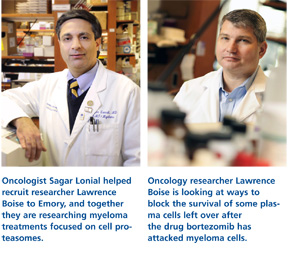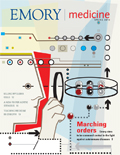Live and let die
Emory researchers have set their sights on speeding up cellular death in their view to a kill of cancer cells.
By Robin Tricoles | Illustrations by Rob Dobi
Like a sharpshooter zeroing in on a target, Emory researchers are honing a new strategy to assassinate cancer cells. Their mission is to treat multiple myeloma more effectively, and they believe a vital clue in their quest lies in cellular garbage.
According to oncologist Sagar Lonial and oncology researcher Lawrence Boise, cells process unwanted proteins in their “garbage disposal”—known as a proteasome. Without a working disposal, the cancer cells die. The two are working to improve drug treatments that disrupt multiple myeloma cells’ ability to clean up their waste by-products. Together they have a research program that takes new treatments for this deadly cancer from the lab to the bedside and back to the lab.
 |
|
“We collaborate in the middle,” says Boise. “Sagar takes what we learn in the middle, the translational part of research, and brings it to the clinic. I take what we learn in the middle and bring it back to the lab for deeper basic research.”
“I think the notion that bench to bedside is a one-way street is probably incorrect,” says Lonial. “Bedside back to bench is probably as important, if not more important, to help understand the basic biology involved in an investigational therapy. Even in a failed trial you still learn something that will help you design the next treatment. So I tell patients when we’re doing a phase 1 trial that I don’t know if it’s going to work, but we’re going to learn something from it to understand better how to treat myeloma.”
Lonial was already conducting clinical trials with the multiple myeloma drug bortezomib when Boise was at the University of Miami teaching undergraduate immunology and researching how cells decide to live or die.
Lonial and Boise met for the first time a few years ago at a conference on multiple myeloma where both made presentations. While awaiting flights home, the pair headed to the airport bar. Over a beer and a lengthy chat, the two decided to collaborate. Boise joined Lonial at Emory’s Winship Cancer Institute in 2009.
Pushing the stress response
Bortezomib, one of the most effective drugs for relapsed multiple myeloma, impedes the work of proteasomes. Bortezomib’s effect is straightforward—it causes cell stress, then cell death, and if the treatment works, remission of the cancer. Lonial and Boise believe one key to developing better myeloma treatments may be centered on proteasomes and are looking into how to better exploit the effects of bortezomib.
“There are always two responses to a stress response in a cell,” says Boise. “The cell tries to alleviate the stress, or the cell recognizes it can’t alleviate the stress, and it kills itself. In cancer therapy that would be a good thing. If you push the stress response hard enough, the response is to die.”
Because plasma cells—myeloma cells are plasma cells run amuck—make and secrete more protein than other cells, they are particularly susceptible to the accumulation of misfolded proteins and thus sensitive to the proteasome inhibition brought on by bortezomib, explains Boise.
“Recent research points to the idea that by treating myeloma with proteasome inhibitors, we are really targeting the plasma cell biology, not the cancer cell biology,” he says.
Bortezomib, however, is not effective in treating all types of multiple myeloma. That’s because each type of myeloma has its own characteristics and may respond differently to specific drugs and therapies.
“There are some data coming out that show some patients may have four or five clones of myeloma,” says Lonial. “Depending on their treatment one clone responds and then a different clone takes over, and you give another treatment and a different clone responds. It’s a moving target.”
Latch the hatch
No matter the type of myeloma in question, some plasma cells survive proteasome inhibition by using a so-called “escape hatch,” really an alternate cellular pathway, to deal with unwanted protein accumulation. That is, the cells sequester unfolded or misfolded proteins into a ball known as an aggresome, which takes up residence in the intracellular space. “This sequestration prevents the misfolded proteins from interfering with normal cellular function,” says Boise.
 |
|
So Boise and Lonial also are looking at ways of blocking this mechanism while inhibiting the proteasome. They are assessing the outcomes of ongoing clinical trials involving bortezomib and another drug, tipifarnib, as well as other combination drug therapies. While bortezomib goes after the proteasome, tipifarnib blocks the aggresome pathway, leading to a hefty accumulation of unwanted proteins in cancer cells and eventual cell death. Tipifarnib is not yet approved for treatment of multiple myeloma and is still in clinical trials.
“When you combine bortezomib with a secondary blocker, you get a whole lot more protein buildup, and the cell doesn’t know what to do with it,” says Lonial. “If the cell can’t figure out how to cope, the apoptotic response will activate, and the cell will die.”
Using a combination of drugs such as bortezomib and tipifarnib not only markedly increases protein accumulation, it also ups the odds of affecting more types of cancer cells, specifically, multiple myeloma’s clones. “If subclone A is susceptible to drug X and subclone B is sensitive to drug Y, and if you use only one drug, one of the subclones will take over,” says Lonial. “But if you use drugs X and Y, maybe you can knock both subclones down. Combination therapy represents the optimal management of this disease—the trick is what to combine.”
In fact, one of the biggest research challenges, says Boise, is determining the number and identity of the best targets. “This disease is really multiple diseases,” says Boise. “So that means there are going to be lots and lots of targets, and that means there’s going to be lots of drugs to develop against those targets. The good news is that some of the targets for myeloma are the same targets for melanoma or lung cancer.”
“We’re interested in validating some of the things we described in the test tube with patients’ samples,” says Lonial. “Winship does this across the board with breast, lung, and other types of cancers. There are few diseases you can cure with one drug, but really understanding how to combine these drugs in patients is critical to our clinical mission.” EM



